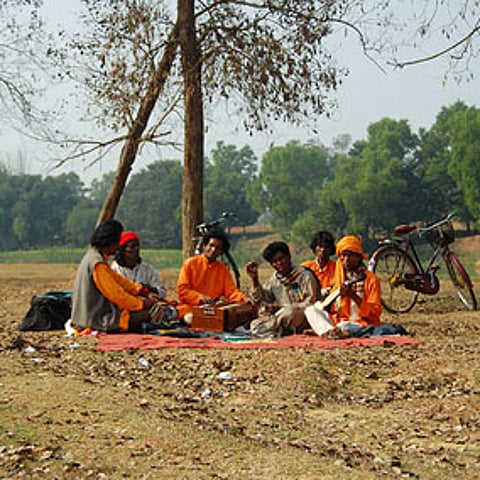In search of a different truth
"Wild and free, they raised their clamour in the mansions of the rich, and roared in gaiety in the courtyards of the poor. They traveled by foot to fairs and festivals. They sang in buses and trains. Their melodies were poignant, their texts enigmatic. Garbed in long, flowing, multicoloured robes… often living in pairs, they played their frenetic rhythms on stage, handmade instruments made of wood and clay, miming the contrary moods of nature and of passion."
– Mimlu Sen in Baulsphere
In 2008, I made my first trip to Shantiniketan, a small town in the Birbhum district of West Bengal, India, the seat of Rabindranath Tagore's Visva-Bharati University as well as home to a large number of Bauls. It was at Bolpur station where I first encountered the voice I would grow to love and follow over the years. The singer was stationed down the aisle from where I was seated, and I recollect approaching him to better hear the song. In front of me, clad in saffron robes, turban on head and dotara in hand (a two stringed instrument often used by Bauls) stood Nimai Chand Goswami. He was singing the most beautiful rendition of the famous 'Lal paharir desheja' as the train entered the red earth zone, so characteristic of the Bengal hinterland. He would go on to sing the same song later the next year at the Jaipur Literary Festival, as a representative of a musical cult that has imbibed musical trends from all over Asia.
The song seemed to evoke a deep sense of nostalgia as well as unrest amongst the listeners, especially in the recurring refrain 'Lal paharir desheja, rangamatir desheja/ Hethake toke maniachhena re, ikkebare maniacchena re' (Go to your country of the red soil/ where you are, it doesn't suit you). Although the song is attributed to the Bauls, it has been traced back to the poet Arun Chakraborty, who said he wrote the lines on seeing a leafless Mahua tree that had blossomed near a railway platform, as if out of nowhere. On a particularly hot April afternoon, the surprised poet – who later went on to eat the flowers, rousing the curiosity of passersby – seemed to be asking of the tree, "why it is there?"

